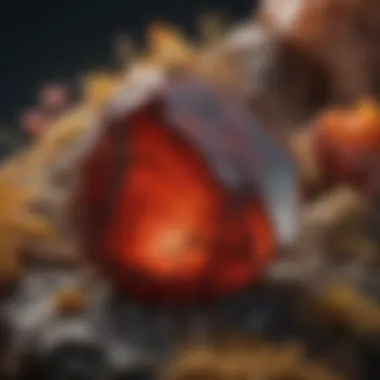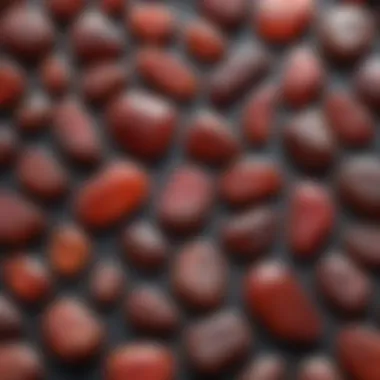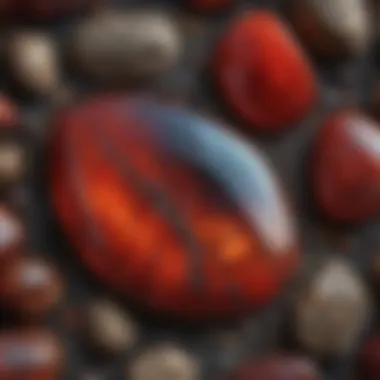Exploring Red Labradorite: Characteristics and Significance


Intro
Red labradorite, a captivating mineral, has attracted attention for its unique characteristics and aesthetic appeal. Unlike its more common counterpart, labradorite, which is often celebrated for its iridescence, red labradorite exhibits a stunning red hue adorned with subtle play of colors. This article will explore the distinctive features of red labradorite, its geological significance, and the factors that impact its availability in the market. Additionally, it will provide insights for collectors interested in ethically acquiring this geological marvel.
Red labradorite's geological formation is as intriguing as its appearance. Understanding its characteristics can enhance appreciation for this mineral, as well as provide valuable information for collectors looking to build a comprehensive collection. This article serves as an extensive guide, offering detailed insights into different aspects of red labradorite to enrich the knowledge of enthusiasts and collectors alike.
Rock Identification
Identifying red labradorite among various rocks can be a nuanced task. To assist with this, several characteristics and tools should be taken into account.
Characteristics to Look For
When examining red labradorite, consider the following aspects:
- Color: The defining feature is the rich red hue. This can vary from deep crimson to lighter shades, often with a slight translucency.
- Luster: Red labradorite exhibits a vitreous to resinous luster, which can enhance its appeal.
- Texture: It generally has a smooth surface, but variations may occur depending on the location of formation.
- Inclusions: Look for subtle inclusions that may reflect light, contributing to its unique appearance.
Tools for Identification
To successfully identify red labradorite, one may find the following tools useful:
- Hand Lens: This is essential for closely examining the mineral's surface for color variations and inclusions.
- Geological Hammer: Useful for extracting specimens, though caution is advised to avoid damaging the rock.
- Field Guide: A reference book on minerals can help in differentiating red labradorite from other similar stones.
By mastering these identification skills and tools, collectors can accurately recognize red labradorite and enhance their knowledge based around this fascinating mineral.
Collecting Tips and Techniques
Collecting red labradorite requires careful consideration and methodical approach. Here are some tips and techniques for effective collecting of specimens.
Best Practices for Collecting
- Respect Nature: Always leave the area as you found it, minimizing any impact on the environment.
- Know the Law: Familiarize yourself with local regulations regarding rock collecting, as some areas may have restrictions.
Locating Prime Collecting Sites
Red labradorite can be found in various geological regions. Some notable locations include:
- Canadian Shield: Known for various labradorites, red varieties can sometimes be identified here.
- Western USA: Certain quarries may yield red labradorite specimens in limited quantities.
How to Safely Extract Specimens
- Use Cushioning: Wrap the specimens carefully to protect them during transportation.
- Avoid Large Rocks: Focus on smaller pieces to manage weight and minimize risk of damage.
Geological Insights
Understanding the geological context of red labradorite enriches the appreciation of its significance.
Geological Formations and Processes
Red labradorite originates from igneous rock formations, where the right conditions allow the unique mineral components to crystallize. This process often incorporates high pressures and temperatures, influencing the mineral's final appearance and properties.
Historical Significance of Rocks and Fossils
Throughout history, labradorite minerals have been sought both for decorative and metaphysical purposes. Red labradorite stands out for its rarity and beauty. Its historical connections to cultures and ancient practices elevate its desirability among collectors.
Notable Discoveries in the Field
Examples of significant discoveries often provide insights into mining practices and geological understanding. Collectors may examine reports and publications on these finds to enhance their own knowledge.


"Red labradorite is more than just a beautiful stone; it is a connection to geological history."
Through a thoughtful exploration of these characteristics, collection techniques, and geological insights, this article aims to provide a comprehensive guide for enthusiasts and collectors to better understand red labradorite.
Understanding Red Labradorite
Understanding red labradorite is crucial for both collectors and enthusiasts. This gemstone is often overlooked in comparison to more well-known varieties. By learning about its properties, collectors can appreciate its uniqueness and the geological significance it holds. Additionally, knowing its defining characteristics helps to make informed decisions when purchasing or evaluating specimens. This section will discuss the definition, geological formations, and aesthetic properties of red labradorite, providing a solid foundation for deeper exploration.
Definition and Basic Characteristics
Red labradorite is a variety of labradorite, a member of the plagioclase feldspar group. It is defined by its striking reddish hues, which can vary from subtle shades of pink to deep crimson. These variations occur due to specific mineral impurities and the way light interacts with the stone's internal structure.
Labradorite stones, in general, exhibit a phenomenon known as labradorescence, where light reflects and refracts to create a stunning display of color. In red labradorite, this unique optical quality may present itself in hues that shift depending on the angle of the light, enhancing its visual allure. Additionally, red labradorite's hardness ranks between 6 and 6.5 on the Mohs scale, which makes it durable for various uses, including jewelry and display pieces.
Geological Formations of Labradorite
Labradorite, including its red variety, forms in igneous rocks, particularly in cooled magma or volcanic environments. Major geological formations where it is commonly found include anorthosites and basalt. Specific deposits of red labradorite have been traced back to regions known for volcanic activity, such as Canada, Madagascar, and certain areas of Finland.
The geological processes that contribute to the formation of labradorite are complex. During the slow cooling of magma, the minerals present crystallize at different rates and under varying conditions. As a result, red labradorite can be formed under specific environmental conditions, leading to its rarity compared to other more common varieties. The significance of understanding these geological factors lies in the ability to trace the origin of specimens, which can inform collectors about their value and characteristics.
Color Variations and Unique Aesthetic Properties
The aesthetic appeal of red labradorite is primarily attributed to its unique color variations and the interplay of light upon its surface. Color is influenced by several factors, including the presence of iron and copper within its composition. Some specimens may display faint tones of orange, yellow, or even earthy browns, which enhances its visual complexity.
The exceptional qualities of red labradorite extends beyond just color. Collectors appreciate the stone's lustrous finish, which can vary from a matte to a glass-like surface, depending on the cutting and polishing techniques used. Its aesthetic properties make it suitable for various decorative and functional purposes, such as pendants, earrings, and even large display pieces. Understanding these aesthetic properties helps collectors discern high-quality specimens when purchasing.
"Red labradorite's unique characteristics and beauty set it apart. Each specimen tells a story through its color and formation."
By grasping the definition, geological formations, and aesthetic values of red labradorite, collectors can enrich their appreciation of this remarkable gemstone. This knowledge serves as an essential framework for exploring the market landscape and the significance of red labradorite in collecting.
Market Landscape for Red Labradorite
The market landscape for red labradorite is a vital section of this article. Red labradorite, while not as widely recognized as some other gemstones, presents a unique opportunity for collectors and enthusiasts alike. Understanding the market dynamics can help collectors make informed choices and navigate potential pitfalls. This includes keeping abreast of pricing trends, recognizing the key players in the industry, and being aware of the platforms available for purchase. Each of these elements contributes significantly to the overall understanding of red labradorite's availability and appeal in the gemstone marketplace.
Current Trends in Gemstone Pricing
Pricing trends for red labradorite are quite distinctive. Unlike more common gems like amethyst or quartz, red labradorite’s value fluctuates based on several factors. Here are some key points regarding its pricing:
- Rarity: The scarcity of red labradorite significantly influences its price. As collectors seek out more unique specimens, prices can rise sharply.
- Quality of Specimens: The quality, comprising clarity, cut, and overall aesthetics, plays a substantial role in determining the price. High-quality specimens can fetch much higher prices.
- Market Demand: Interest in red labradorite is increasing, which can enhance its value. Collectors are always on the lookout, and this demand can lead to better pricing for finer stones.
Understanding these factors is essential for anyone looking to invest or simply collect red labradorite. It is advisable to keep an eye on the market fluctuations to buy before prices peak.
Key Players in the Market
The market for red labradorite comprises several key players, including suppliers, wholesalers, and retailers. Some notable entities include miners who extract the mineral, and companies that polish and sell stones. Recognizing these players helps collectors be more strategic in their purchasing decisions. The presence of established gemstone retailers like GemSelect and The Natural History Museum offers credibility and reliability in sourcing authentic specimens. It is important to buy from reputable sources to avoid counterfeit products. Knowing who the key players are can aid in establishing trust and transparency in transactions.
Online Platforms and Retailers for Purchase
The rise of online shopping has made acquiring red labradorite more accessible than ever. Several platforms stand out in the market:
- Etsy: This platform features many independent sellers offering unique pieces, including stunning red labradorite.
- eBay: A place where collectors can bid on or purchase labradorite from various sellers. It’s essential to check seller ratings before making a purchase.
- Amazon: Provides a vast array of options, though caution is advised due to variability in quality and authenticity.
- Specialized gem retailers: Websites like Ron Coleman Mining and Crystallized offer a selection of gems, including red labradorite, often with good quality assurances.
Navigating these platforms can simplify finding the right piece for your collection. However, always ensure to read reviews and perhaps consult community feedback on forums such as reddit.com to gather opinions on particular sellers.
Understanding the market landscape can empower collectors to make informed decisions, ultimately leading to more satisfying acquisitions.
The Significance of Red Labradorite in Collecting


Red labradorite holds a unique position in mineral collecting due to its distinct features, historical background, and metaphysical associations. Collectors often seek this mineral not only for its aesthetic qualities but also for its cultural significance and the intrigue it brings. Understanding these facets can enhance a collector's appreciation and provide deeper insights into this captivating stone.
Cultural and Historical Context
The lore surrounding red labradorite is rich and varied, extending through different cultures and epochs. Historically, labradorite has been used since ancient times, with some tribes valuing it as a tool in spiritual rituals. The red variant, while less common, also resonates culturally. Native tribes believed these stones held protective properties and can offer guidance. This belief system contributes to the stone's desirability among modern collectors, who appreciate not just the physical attributes but also the history and narratives associated with the mineral.
Spiritual and Metaphysical Beliefs
Many people delve into the realm of metaphysics when collecting minerals, and red labradorite is no exception. This mineral is often regarded as a stone of transformation. It is believed to harness energy that can enhance intuitive abilities and foster emotional healing. Collectors often seek specimens believed to carry these energies, tying the value of their collection to perceived spiritual significance. Thus, owning red labradorite often goes beyond mere aesthetics; it becomes a personal journey of self-discovery and enlightenment.
Aesthetic Appeal and Display Characteristics
The visual allure of red labradorite is compelling. Its striking colors, often interspersed with shades of red, brown, and sometimes even hints of orange, create a dynamic appearance that captures attention. When displayed, these stones can evoke strong responses due to their reflective qualities that shift under different lighting conditions. Collectors often use display cases that highlight these unique features, emphasizing the stone's raw beauty and enhancing the overall collection presentation.
Evaluating Red Labradorite for Sale
Evaluating red labradorite before purchase is crucial for collectors. Understanding the quality and authenticity of specimens can directly influence their value and the collector's satisfaction. Not every piece of labradorite will possess the sought-after visual qualities or structural integrity. Thus, it is essential to know what to look for, comprehend various treatment techniques, and verify the authenticity of claims made by sellers.
What to Look For in Quality Specimens
When assessing red labradorite, several factors determine its quality:
- Color Depth: High-quality red labradorite displays a rich, vibrant red hue. Look for an even distribution of color without fading.
- Luster: A glossy or high shine finish enhances the stone's appeal. It indicates good polish and quality.
- Transparency: Quality specimens may have some translucence, which allows light to enter and showcase the internal features of the stone.
- Inclusions: Minor inclusions may be present; however, excessive inclusions can detract from value. A clear stone is often desirable.
- Cut and Shape: The craftsmanship of the stone can affect both its beauty and its usability in jewelry or display.
It can be beneficial to compare multiple pieces to better understand the range and select the best specimen.
Understanding Treating Techniques
Many gemstones, including labradorite, undergo various treatments to enhance their appearance. Collectors should know these processes as they affect value and authenticity:
- Enhancements: Some stones are subjected to heat or radiation for color improvement. Understanding these can help you evaluate a stone's worth.
- Stabilization: This process can improve the durability of a specimen. While it is common for collectors to choose stabilized stones, they might not appeal to purists who value natural conditions.
- Resin Treatment: Coating stones in resin can enhance their shininess and make them more appealing. However, this can mislead buyers regarding the genuine quality of the stone.
Being aware of these techniques will assist in making informed purchases and understanding what a product might need in terms of care.
Authenticity and Certification Options
Ensuring that red labradorite specimens are authentic is vital. Here are steps to verify authenticity:
- Certification from Reputable Labs: Check if the seller provides a certificate of authenticity from an accredited gem laboratory.
- Research Established Dealers: Buying from recognized dealers with positive reputations is often safer.
- Understanding the Stone's Origin: Familiarizing yourself with the known sources of red labradorite can help in identifying potential counterfeit versions.
Ethical Considerations in Mining and Sale
Ethics in mining and sale of minerals like red labradorite cannot be overstated. The repercussions of mining extend beyond economic gain; they touch on human rights, environmental sustainability, and societal well-being. As the demand for unique minerals rises, the necessity for responsible practices in their extraction becomes critical. Understanding these ethical considerations helps not just in making informed purchasing decisions but also contributes to the ongoing dialogue about sustainable practices in the mineral industry.
Sustainable Mining Practices
Sustainable mining practices are essential for minimizing harm to the environment and communities. This includes adopting methods that reduce the ecological footprint of mining activities. Techniques such as selective extraction and the use of non-toxic materials in processing can prevent soil and water contamination. Companies are increasingly expected to undergo environmental impact assessments before operations begin, ensuring that surrounding ecosystems are preserved.
Sustainable practices also promote a cycle of responsibility. By focusing on long-term health of both the land and local populations, miners can enhance their reputations and offset potential backlash from consumers concerned about ethical sourcing.
Environmental Impact of Labradorite Extraction
The extraction of labradorite, especially in large quarries, poses various risks to the environment. Forests may be cleared, wildlife habitats disrupted, and water supplies affected. In some regions, irresponsible mining can cause erosion and sedimentation, impacting local aquatic life. The land's natural beauty and biodiversity suffer drastically due to destructive practices.
Miners are beginning to realize the importance of conducting operations that mitigate environmental damage. This can include using machinery that minimizes land disturbance and employing methods to rehabilitate sites post-extraction. Together, transparency and technological investment can ensure that labor is compliant with environmental laws and beneficial to future generations.
Supporting Fair Trade in Natural Resources


Fair trade initiatives play a pivotal role in fostering ethical practices within the mining industry. Supporting such programs enhances the welfare of miners and their communities. By ensuring fair wages and safe working conditions, producers have access to resources necessary for their families and communities.
Organizations that monitor the practices of mining companies advocate for fair trade guidelines and transparency. By purchasing red labradorite from suppliers who adhere to these standards, collectors can make choices that align with their ethical beliefs. This support not only helps uphold fair practices but also generates awareness around the importance of ethical sourcing.
"Ethical mining is not just about profit; it is about the legacy we leave behind for future generations."
Ultimately, conscientious sourcing of red labradorite is imperative. Consumers who prioritize ethics contribute to a more sustainable and equitable market, promoting responsible mining practices that respect both the environment and its stewards.
Care and Maintenance of Red Labradorite
Maintaining red labradorite is crucial for collectors who appreciate its unique aesthetic and geological significance. Proper care not only preserves its beauty but also ensures that this mineral can be enjoyed for years. Understanding how to clean, store, and protect red labradorite is essential in cultivating a quality collection. An informed approach to care can enhance the durability and overall presentation of specimens.
Cleaning Procedures and Best Practices
Cleaning red labradorite requires a careful touch to avoid damaging the stone’s surface. It is advisable to utilize soft, lint-free cloths for daily dusting. For more thorough cleanings, using lukewarm water mixed with a mild soap is effective. Avoid harsh chemicals or abrasives, as they could lead to surface scratches.
After cleaning, it is ideal to dry the stone immediately with a soft cloth. This prevents water spots and maintains its luster. Remember to avoid prolonged exposure to water. If the stone has intricate facets, a small, soft brush can assist in removing debris from hard-to-reach areas.
Storage Solutions for Collectors
When it comes to storing red labradorite, the goal is to minimize exposure to potential scratches or damage. Using a soft pouch or a dedicated display case is effective. Pouches made of velvet or microfiber offer protection against both scratches and dust.
Display cases that allow for airflow can keep the stone safe while showcasing its beauty. If you are storing multiple specimens, placing separators between stones can prevent contact, which could result in chips or scratches. Avoid placing red labradorite in direct sunlight for extended periods, as UV rays can alter its vibrant colors.
Preventing Damage and Ensuring Longevity
The longevity of red labradorite largely depends on how it is handled and stored. It is important to treat these specimens gently. Avoid dropping or knocking them against hard surfaces.
Additionally, consider environmental factors that can affect the stone. Extreme temperatures, high humidity, and sudden temperature changes can cause cracks or affect its appearance. Keeping the specimens in a climate-controlled environment can mitigate these risks.
In summary, understanding how to care for red labradorite ensures its health and longevity. Proper cleaning, storage, and handling practices are necessary to maintain its beauty and value.
By following these guidelines, collectors can preserve their red labradorite specimens and appreciate their elegance for many years.
Connecting with the Collecting Community
Connecting with the collecting community is crucial for anyone interested in red labradorite. This network provides not just a sense of belonging, but also the opportunity to learn from experienced collectors and share insights about this unique mineral. Engaging with fellow enthusiasts helps to enhance understanding and appreciation of red labradorite, fostering a culture of respect and responsibility around mineral collecting.
One significant aspect of connecting with this community is gaining access to rare specimens that might not be available through mainstream channels. Collectors often trade, sell, or give away pieces from their collections, opening doors to unique finds. Furthermore, being part of a community offers support in evaluating the authenticity and quality of specimens, which can be particularly useful for novice collectors.
Another benefit lies in educational resources. By networking with others who share similar interests, collectors have opportunities to learn about care techniques, storage best practices, and the latest trends in the market. This exchange of information can greatly enhance the knowledge base for all members involved, regardless of their collecting experience. Without doubt, these shared discussions can be highly enlightening.
"Investing time in a collecting community can greatly enhance both knowledge and enjoyment of the hobby."
In summary, the connections fostered within the collecting community are invaluable for deepening insight into red labradorite and other minerals. Building these relationships is not only beneficial for acquiring specimens but also fosters a rich environment for shared learning and growth.
Finding and Joining Collecting Groups
Finding and joining collecting groups can significantly enrich the experience of any enthusiast. Many local and online communities exist where collectors convene to discuss their favorite minerals, share tips, and trade specimens. Websites like Facebook often have groups dedicated to specific minerals, including red labradorite, where members can post questions or showcase their latest finds. Local rock clubs and mineral societies also provide structured environments for collectors to meet in person.
Being active in these groups not only introduces you to a network of like-minded individuals but also will help you stay updated on shows, sales, and other events relevant to mineral collecting. These gatherings often provide a more relaxed atmosphere to meet fellow collectors and strengthen one’s knowledge in a communal setting. Joining such groups fosters friendships and can enhance the joy of collecting.
Sharing Knowledge and Best Practices
Sharing knowledge and best practices is vital in any collecting community. Members are encouraged to exchange information about different varieties of labradorite, which can include the nuances of red labradorite specifically. Those who understand the geological formation of these minerals can provide insights into their significance and rarity.
Moreover, sharing best practices in cleaning and maintaining specimens not only helps preserve their beauty but also educates new collectors on proper methods. The collective understanding that emerges from this shared experience improves the overall quality of information circulating within the community. The adage, "What you learn, you should pass on," reflects the spirit of generosity that many collectors embody.
Participating in Fossil and Mineral Shows
Participating in fossil and mineral shows can be a transformative experience for collectors. These events often feature a diverse range of specimens, and red labradorite enthusiasts may find particular varieties they have been seeking. Beyond the chance to buy or trade stones, shows hold workshops, lectures, and exhibitions that provide deeper insights into geological sciences and collecting.
At shows, collectors can interact with vendors who specialize in labradorite and related minerals. Touching and examining stones in person also offers opportunities to assess quality in ways that photographs cannot. Furthermore, these gatherings ignite the excitement of learning directly from others, making it an enriching experience.







